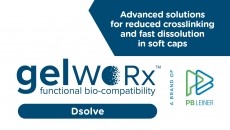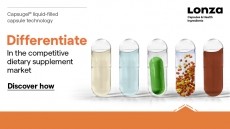VITAFOODS PREVIEW
Latest innovations in bioavailability and delivery systems

“According to a 2024 report by McKinsey, the main features customers look at in choosing a wellness product are efficacy and scientific credibility," Emiliano Pena, senior content producer for Informa Markets, told webinar attendees. "Also, more consumers are interested in biomonitoring—tracking their biomarkers—because they want to make sure they aren’t having any nutritional deficiencies.
“In other words, consumers want to be assured the products they are taking are exerting the beneficial effects they claim, these are backed by science, and these are beneficial to their overall health.”
Co-host Niamh Michail, head of publishing at Vitafoods Insights, noted one start-up innovating in the space of bioavailability is Aelius Biotech, spun off from the University of Newcastle, which has developed an in vitro gut microbiome system with a mucus barrier. Thanks to the mucus barrier, it can measure both digestion and absorption of a range of active ingredients.
She explained the model has proven particularly useful for probiotic manufacturers who can discover if their product is destroyed by the stomach's acidic environment or if it is delivered safely to, and released in, the gastrointestinal tract.
Discussing other innovations in this field, Pena noted the Indian Institute of Science, Education and Research has developed an AI tool named GutBug, which can predict how microorganisms transform the compounds that reach the gut and therefore how the compounds will behave.
“It will be fascinating to see how this AI tool will be used by nutraceutical developers,” he said.
Sustainable delivery and smart combinations
A number of brands have been looking into bioavailable vegan alternative sources for nutrients traditionally derived from animal sources.
For example, Michail spotlighted the Latvian firm Nateo, which makes vegan vitamin D3 from algae as opposed to sheep’s wool or fish oils.
Tracking patent applications using Mintel’s Cipher patent search tool, Michail revealed Danone recently filed a patent describing how adding fiber can boost the bioavailability of iron.
The patent notes that only around 10% of iron is absorbed, with most passed into the colon where it encourages the growth of bad bacteria, and good bacteria don’t feed on iron.
She explained: "The Danone scientists say that when galacto-oligosaccharides (GOS) and fructo-oligosaccharides (FOS) are added to a cereal product, they work synergistically to increase the bioavailability of the iron so it’s absorbed by the body more quickly, meaning the person can reduce the number of supplements they take and then can reduce adverse effects on the gut."
Encapsulation, emulsions and nanocarriers
Aarthi Janakiraman, research director at the business consulting firm Frost and Sullivan, provided an overview of the latest technologies for improving bioavailability of nutraceuticals, including micro and nanoencapsulation, which are "quickly becoming the industry's choice in stabilization".
Some other techniques gaining interest are liposomes and nano-emulsions, such as bilayer and phospholipids because they can encapsulate hydrophilic and lipophilic materials, giving developers a wider choice of compounds.
She added another interesting delivery technology is lipid-based nanocarriers and nanophytosomes.
Phytosomes use biocompatible lipids to which the bioactive compounds are bound by hydrogen bond, forming a phytocomplex. Nanosized phytosomes, nanophytosomes, increase bioavailability, stability and efficacy.
"We are also seeing surface modification techniques and combination systems such as multi-layered emulsions wherein the researchers create multi layers of emulsions to increase the bioavailability or sustainability of ingredients," she added.
Asked about freeze-dried drops as a nutraceutical delivery system, the researcher said this method is gaining traction as it can preserve the properties of the bioactive, protect some of the sensitive components from heat and moisture, as well as provide a longer shelf life thanks to moisture control. What’s more, the lack of heat in production means heat sensitive ingredients can be protected.
“There is a high amount of research in this technology for the development of VMS supplements, bioactive sand heat sensitive compounds," Janakiraman added.
However, she noted this is a little more expensive than other delivery systems in the market and that the technology could involve a longer development lifeline.
Dr. Sun-Ho Frank Kim, president of SEAH Bio Solution, presented his company's AI platform Natura Predicta to identify new active ingredients in botanicals without the need for preclinical or clinical testing, which could be used to develop new types of functional foods in South Korea.
Noting some drawbacks in this space, he explained many AI technologies are based on ‘dry lab’ research, meaning they are based on computational, mathematical and public domain research, so combining these with ‘wet lab’ research—using physical samples, chemicals and liquids—will improve the power of the AI to predict bioavailability of ingredients.











